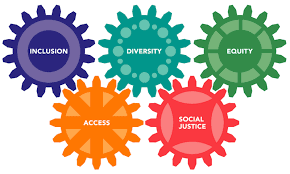by Molly Penn
We’ve been going over all of our “traditional” organizational development practices with a fine tooth comb to build the IDEA lens into everything we do with clients. This article focuses on strategic planning and how to rethink the process of planning so the result is a plan that furthers the organization’s IDEA competence in every facet of its work. What follows is a step by step approach to rethinking the planning process to ensure inclusion, diversity, equity, and access are built into the resulting strategy.
Inclusion is Personal
Strategic planning with an IDEA lens is not a dispassionate endeavor – it is deeply personal. It will call into question long held beliefs and assumptions and it will shake us up. Therefore it is vital to start by connecting to our most personal and highest aspirations in life. We like to open the process by asking our clients:
- “What is your purpose and motivation – what does your life call you to do?”
- “What about that calling brought you to this work?”
With these two questions, we begin from a place that is grounded in our highest aspirations for changing the world. This is the true north that is important to stay in touch with throughout the process.
Ask equity questions questions
One of our old blog posts seems to be a perennial favorite, How to Frame Powerful Strategic Questions. In short, every planning process is framed by a set of strategic questions – the areas of particular focus for the development of strategy. Every organization starts this journey from a different place, but some of the questions that are fairly universal these days address the racial justice movement and the aftermath of the pandemic. Here are some of our favorites:
- How have the needs of those you serve changed as a result of the pandemic and the racial justice movement?
- What are the systems that most affect the people we serve and how do they help or hinder our work?
- What relationships should we forge to better serve the people at the center of our mission?
- How can we ensure that our constituents have equitable access to our programs and services?
- What focus areas would move us from crisis management to creating meaning for those we serve?
- What are the practices, policies, procedures, values, and cultural norms that have been “immovable,” that have been in place for too long – or perhaps never should have existed at all?
Always be sure you are centering those who are historically the most marginalized and their voices as you move through the process – those who are typically not at the strategic planning “table.” Those from whom we hear the least often. Finally, it is important to ground IDEA plans in a set of organizational values, so we make sure we build those into the process if they need to be created or updated.
Inclusive Research & Data Gathering
It is important to focus research at the systems level. If we stop at the traditional landscape analysis, we might be missing important information that will help our clients create real impact for those they serve. Map the systems of power (both formal and informal) that can help or impede the organization’s work. Analyze the forces at play that will influence the work going forward. Then you have a more complete picture of the context in which the organization works and how that context is influencing the work.
When doing stakeholder interviews, it is important not just to hear from the constituents but to have the clients do the interviews with them so they don’t hear from them through an interpreter. We can supplement those interviews, but what is most important is connecting the clients with their constituents to hear first hand their answers to some of these questions.
Hold Space for IDEA
We structure the planning meetings to hold space for several important activities:
- Invite non-traditional partners into the process wherever possible – those most affected, policy makers, partners
- Observe the findings from the data gathering, without judgment – just absorbing them
- Notice where prevailing mental models are being challenged by new information
- Hold space for letting go of “the way we do it” to allow new ways to emerge
- Reconnect to our shared higher calling that brought us to this work
- Co-creating new paths forward that are innovative and speak to this new information
Also, it is very important to ensure the internal capacity goal addresses the ways internal practices need to shift or be upheld to support IDEA principles – specifically around power dynamics, policies, values, decision-making structures.
IDEA Implementation
With IDEA plans, it is particularly important to not stop at pretty words and good intentions. Therefore, we only do IDEA plans when we can also create an implementation plan that speaks to how to put the intentions into actions. When unlearning and relearning, we all need supportive structures to guide us in building new habits. We will make mistakes, and learn from them. But a strategic plan that for the first time builds in IDEA without an implementation plan runs the risk of perpetuating performative allyship.
Want help planning with an IDEA lens? Talk to us!

